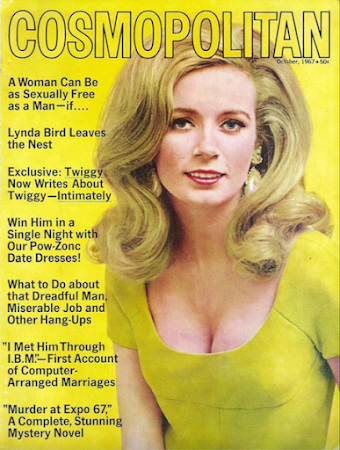Harsh Evidence
Pamela Fry
London: Wingate, 1953
172 pages
Because this is a Canadian country house mystery, the house isn't terribly old and servants not so numerous. Rocky Crest is located on a private island in a lake somewhere in Northern Ontario. Belonging to wealthy Toronto businessman J.H. Charleston, it is a two-storey mid-century modern, complete with floor-to-ceiling plate glass windows and – here I assume – Danish furniture.
J.H. has invited employees and their spouses for a relaxing weekend, though no one is at all relaxed. Guests include:
- Randy Matthews, the top copywriter with Charleston & Synge Advertising. He's here with wife Ann, who worries that his time at the company is limited.
- Iris Martin, dress designer, owns a Bloor Street shop in which J.H. has chosen to invest. She is the latest in in Randy's "long string of entanglements."
- Peter Fairweather, a commercial artist working within the Charleston business empire, has brought his wife Lois, "a small, bird-like woman in her mid-thirties."
- Gordon Goodman, an accounts executive with Charleston & Co is also present, with his wife, "that silly Marion," in tow.
And then there's protagonist Beth Manley. The daughter of a "Toronto University" professor who died far too young, she's the editor of Glitter, J.H.'s latest and most ambitious publishing venture. Unlike the others, this is her first visit to Rocky Crest. Very much outside her element, she's found a friend in Ann, who warns against "Charlestonitis":
"New arrivals to Rocky Crest are particularly susceptible. First symptoms are a dampness in the palms and an irresistible urge to say 'Yes' every time J.H. opens his mouth."
A cautious soul who is very much outside her comfort zone, Beth is made more tense upon learning that her former lover, journalist Paul Manning, is due to arrive.
She awaits Paul's arrival, just was the reader awaits the discovery of the dead body described in the italicized first paragraph:
In time she would be found—but not yet. The shock and terror of her discovery were still to come. Now she floated peacefully at the edge of the island, the spreading web of blonde hair framing her clear, pale face, the wet green silk of her dress clinging to breast and thigh. Her ballerina slippers were gone—it had been easy for the water to pull them away. And as the small waves lapped her cheeks, her head moved as though she turned it in her sleep. But she was not sleeping.
It's Beth who finds the body. She'd given liquor to steady herself as things begin spinning out of control.
 |
De döda talar ej [Harsh Evidence]
1956 |
Harris, Charleston's handyman, fishes the lady from the lake. He takes the body to the toolshed, which everyone somehow agrees is appropriate, and then sets out for the mainland and the police. His departure is followed by a sudden storm, leading all to wonder if he'll be coming back at all.
But, look, a boat!
It's not Harris, nor the police, rather late arrival Paul:
Marion flung herself upon him.
"Paul, darling! We're so glad to see you! We've had the most dreadful time!
Harsh Evidence may be a Canadian country house mystery, but the characters speak like proper Brits.
Marion's slobbering excitement at Paul's arrival is tempered somewhat by J.H., who tells the journalist about the drowned woman. No sooner has his story ended than Marion stumbles upon a heart-shaped locket in the grass. It would appear to have fallen while Harris was carrying the body to the toolshed. Paul inspects it and turns a whiter shade of pale:
"I think she was my wife."
Turns out he's right.
Beth had no idea that Paul was once wed. When the two are alone, he relates a sad, sordid story of love and betrayal... and then it's off to dress for dinner!
The women go all out. Ann dons on a white dinner dress that possesses "a rakish charm," Lois engulfs herself in yards of grey velvet topped by a little pearl cap, and Iris has "poured herself into a strapless dress which appeared to be made of black sequins." You'd think the dress designer would have the advantage, but it's Beth who makes the biggest splash:
Gentlemen! Lady! I remind you that this very afternoon a woman, Paul's ex-wife Lizette, was found dead floating not far from this very house. Beth, you were the one who found her. Randy, Gordon, you walked down to the shoreline to help retrieve the body.
The 26 September 1953
Globe and Mail review features some backhanded praise:
I didn't think much of J.H.'s guests, Beth included, but these intolerable four-flushing types are what makes Harsh Evidence worth reading. Careerists all, we dodge them in life, but are drawn to them in print.
All enjoy a perfectly lovely dinner, after which Peter tinkles the ivories and Iris does a substandard Dietrich imitation. The host waltzes with Lois in all her velvet, then suggests a game of Kidnapped.
Kidnapped?
Kidnapped is one of Randy's creations. It's something like Hide and Go Seek, but with teams and rhyming clues.
What fun! But how strange.
The novel's great flaw lies in the callous and peculiarly uniform behaviour by a group of people who had mere hours earlier witnessed Harris retrieve of the body of a dead woman. Some of this may be explained away by the slow reveal that Paul was not the only member of the party to have, let's say, known Lizette.
 |
Kuolleet eivät puhu [Harsh Evidence]
1957
|
It's not often that I share a spoiler. I do so here because Harsh Evidence is unique in Canadian mystery writing of the time.
As the novel's mid-point approaches, Ann tells tells Beth about Iris's tragic history. The father was disinherited for marrying a chorus girl, Iris's mother. After losing what remained of his money in the crash of '29, he took a drive out a window. J.H., a friend of the family, paid for an exclusive girls' boarding school from which Iris was subsequently expelled. It's only in recent years that the two resumed cordial relations:
"It's certainly romantic," Beth said. "Positively Victorian. Somehow it doesn't fit Iris."
"There are a lot of things about Iris that don't fit," Ann said slowly.
"Oh? What, for example?"
"Well, the men she collects – considering how hard she works at being a glamour girl – they're a pretty queer bunch."
I identified the last sentence as a
bloomer, but the final chapters led me to reconsider. By this point, the reader has come to see Lizette Manning (née Lily Roberts) for what she was, a
femme fatale who had mined men for money and sex. The twist comes when it is revealed that Lizette saw another mark in Iris, who confronts her on the morning of the afternoon her body would be found.
Ultimately, it's Gordon who exposes the murderer:
Interestingly, Iris herself had used sex – or the promise of sex – to get Randy to agree to a scheme involving the sale of insider information to J.H.'s competitors.
For these reasons alone,
Harsh Evidence is worth a careful second reading.
About the author: Following early, lazy research on Miss Fry, the newly released 1931 census provides a touch more information. Pamela Fry is recorded as the 14-year-old English-born daughter of John and Charlotte Fry. The family had emigrated to Canada in 1928. The Frys lived at 46 Spencer Avenue in Toronto, sharing the house with Edward and Freda Jones and their three daughters.
The house still stands, though you can't see much of it in this 2020 Google Maps Street View.
Object and Access: A hardcover consisting of pale green boards and post-war paper, only the dust jacket illustration renders it attractive. Credit goes to Patric O'Keeffe, about whom I know very little.
The novel can be found at Library and Archives Canada, Bibliothèque et Archives nationales du Québec, the University of Toronto, McMaster University, New York University, Occidental University, Trinity College Dublin and, most remarkably, the Atmore Public Library in Atmore, Alabama.
Here's to the Atmore Public Library!
I purchased my copy earlier this year from a UK bookseller. Price: £7.50. As I write, one copy of the Wingate edition is listed at the very same price I paid. Though lacking the jacket, it seems a good buy.
In 1956, New York's Roy Publishers published the first and only American edition. I've never seen a copy.
Harsh Evidence has enjoyed two translations, the first being the Swedish De döda tala ej (1956). This was followed by a Finnish translation titled Kuolleet eivät puhu (1957). Neither cover depicts a scene that features in the novel. Ditto the frocks.
Harsh Evidence has never been published in Canada.
Related posts:




































